Academic Tracking in Public High Schools in the Bronx: A Resource Gap, not an Achievement Gap
By Kristal Estrella
The practice of academic tracking in the Bronx, as well as the rest of New York City, presents a “tale of two school systems”.
Whether known as academic tracking, streaming, sorting, or ability grouping, the practice of grouping students based on academic ability represents a form of racial and socioeconomic segregation that ultimately keeps White affluent parents from completely abandoning the public school system. Specialized high schools and Advanced Placement (AP) courses are two components of academic tracking in public high schools that allow for students of higher socioeconomic status to be sorted into upper tracks and separate minority students into lower track classes and curriculum–thus contributing to two separate school systems.
The Role of Specialized High School in Academic Tracking
Bronx High School of Science is a specialized, public high school, ranked 3rd among all New York City public schools. Admission into the school is solely based on a competitive examination known as the Specialized High Schools Admissions Test (SHSAT)—an exam that is open to eight and ninth graders who wish to be considered for the school, as well as any other specialized high school within the five New York City boroughs. The SHSAT examination and application is only available for students to register through their middle school guidance counselor who determines whether they should receive an admission ticket to apply—already demarcating the admissions process for students and presenting exclusivity.
While the Bronx has identified high-achieving institutions among its school districts, they have also listed and ranked the lowest achieving schools in the borough. The Bronx has identified over 30 public schools in its county that are ranked within the lowest tier, and labelled by the state as ‘struggling’ or a “Comprehensive Support and Improvement School”. State officials considered performance on science exams, and progress of tests taken by English learners, and schools that were not able to graduate 67% of students within a time span of 6 years were automatically identified and labeled as “struggling”. Among these schools is New Visions Charter High School for Advanced Math and Science II, ranked worse than 99.8% of high schools in New York in 2018.
In the Bronx, the racialization of academic tracking, among and within public schools, becomes apparent when we analyze the way Black and Hispanic students are starkly underrepresented in specialized high schools within districts localized in minority-populated neighborhoods. This can be seen when we examine the demographics of enrollment at Bronx High School of Science, and compare it to the demographics of enrolled students at New Visions Charter High School for Advanced Math and Sciences II (Figure 1).
The lack of diversity of race and socioeconomic status, in the specialized high school that is needed to closes achievement gaps, is lacking among specialized high schools like Bronx High School of Science. Instead, hyper-segregation through the means of admission into specialized high schools seems to greatly exacerbate opportunity gaps.
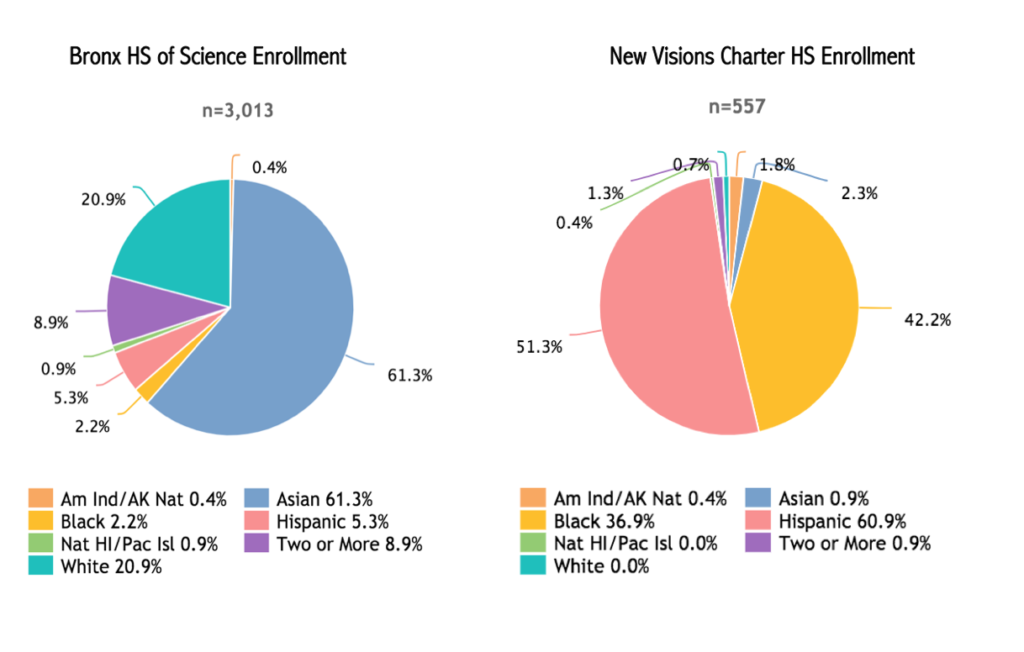
The Role of AP Exams in Academic Tracking
Advocates of academic tracking have gone as far as to argue that minority students are at an advantage when placed in small groups with other high-achieving students in separate advanced classes, because it gives them the opportunity to master and prepare for higher levels of mathematics and science, which can contribute to closing the achievement gaps between high-IQ Blacks and Whites as well as high IQ-Hispanics and Whites. However, even as more Black and Hispanic students are offered enrollment to take AP exams, the proportions of those students passing AP exams has shrunk, thus widening the pass-rate gap between those students and their White and Asian peers. In contrast, White and Asian students exhibited a rise city-wide in both the number of students participating in AP and an increase in pass rates with roughly 66% of White test-takers and 67% of Asian test takers passing at least one AP exam—demonstrating an increase for both groups since 2016 . While Black and Hispanic students receive the opportunity to be placed in higher-achieving academic settings, they are still outnumbered in these higher-level courses and schools in comparison to their White counterparts.
An assessment of Advanced Placement (AP) enrollment and admissions between Bronx High School of Science and the lowest performing high school, New Visions Charter High School for Advanced Math and Science, reveals that while Black and Hispanic students make up nearly 70% of New York City’s public school system, students enrolled in AP courses and passing exams, remain largely represented by White and Asian students. Additionally, it appears that the lowest performing high school in the Bronx, though it offers AP enrollment and exams, there is a limited number of AP courses offered and the few course that they do offer, are largely comprised of students of color struggling to pass these exams (Figures 2 & 3).
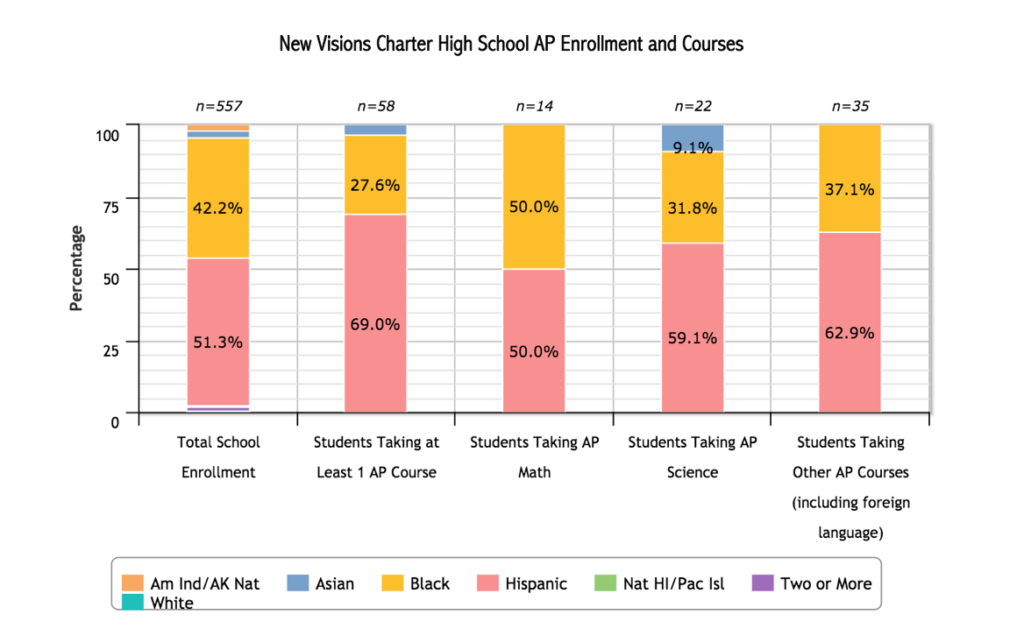
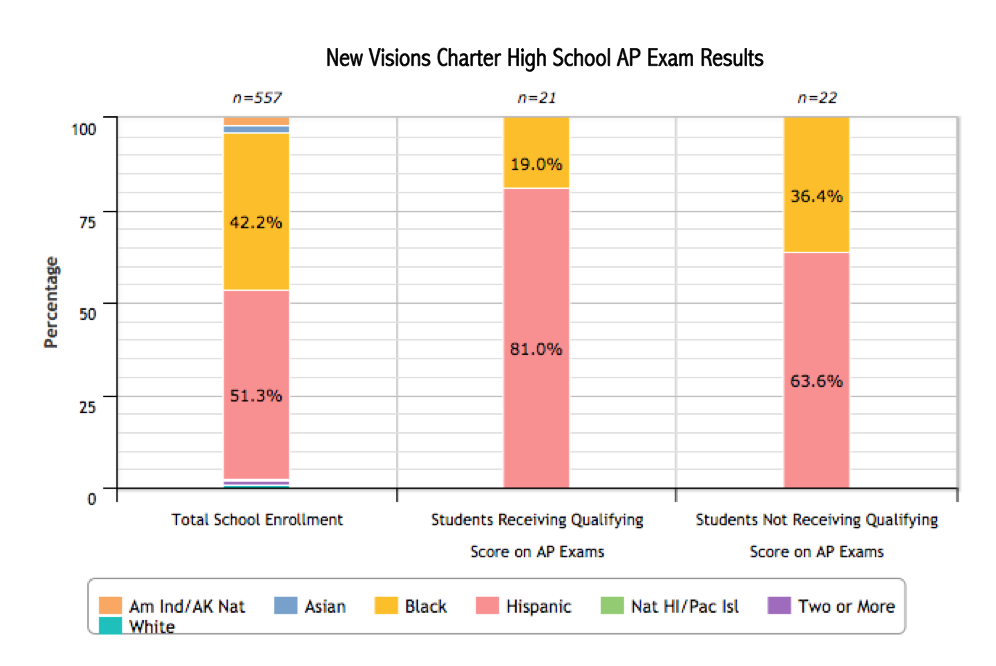
According to the Office of Civil Rights Data, Bronx High School of Science offers 20 different AP course to its student body, which is comprised of a population of 61.3% Asian, 20.9% White, and only 2.2% Black or African American and 5.3 Hispanic or Latino students[1]. Students with disabilities make up 1% of the student body population, and 0% of the population is representative of students with Limited English Proficiency (LEP). For New Visions Charter High School, there is a stark difference in representation of the student body, with 43.7% Black students, 46.3% Hispanic or Latino, and only 2.1% Asian and 0.9% White. Additionally, 16.4% of the population consists of students with disabilities and 7.2% are students with LEP. According to New York State Education Data 79% of students in New Visions Charter High School are disadvantaged, whereas 46% of students in Bronx High School are considered economically disadvantaged, based on the same report from 2015-2016. For its entire school body, New Visions Charter High School only offers 6 AP courses (Figure 2).
In New Visions Charter High School, a total of 42 students in 2015 were reported as taking at least 1 AP course and only 39 students went on to take AP exams for AP courses. Among those that took AP exams, 56.4% of the students were Black, 33.3% Hispanic and 5.1% White. Out of the 39 students that took the AP exams, 4 students received qualifying AP scores (Figure 3). These numbers are drastically different when comparing AP placement and scores to students of the Bronx High School of Science—where almost 70%, 2,068 students of the entire school body went on to take at least 1 AP course (Figure 4). Among the students taking AP scores, 59.5% of students were Asian, and 23.3% White. A total of 5.1% were Hispanic students and 1.9% were Black students enrolled in AP. The same trend was exhibited when highlighting the number of students and their demographics for which students go on to taking AP exams, with over 80% of the student population taking AP exams being White or Asian and less than 7% (6.1%) Hispanic or Black. This statistic represents the way in which academic tracking is racialized with majority of the students taking AP exams being White and Asian.
Lastly, when analyzing the composition of students not receiving qualifying scores on AP exams, the number of Black students representing the group is about double the percentage points of Black students representing students receiving qualifying scores, with about 1.5% Black students with qualifying scores, and about 2.4% of 165 students not receiving qualifying scores(Figure 5). These numbers demonstrate that although some may see academic tracking as a beneficial factor because it allows students to challenge themselves and prepare for college, it is weak to argue that the practice works well in closing the achievement gap between students of color and White students, given that not many students of color are granted the opportunity to be placed into such classes, and remain underrepresented when comparing the number of White students in specialized high schools and/or enrolled AP courses.
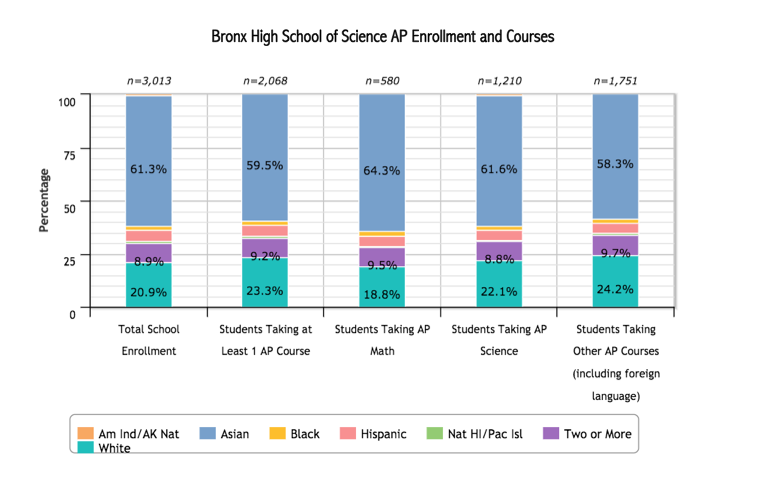
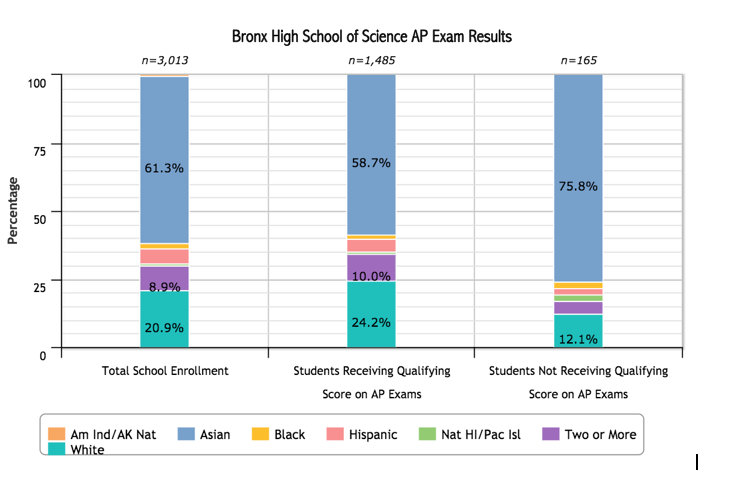
Public Schools Are Indispensable
It is generally assumed that because an educational institution is public, it is substandard. In urban communities like the Bronx, racial disparities between predominately White, private institutions and predominately Black, public institutions are highly evident. In the Bronx, public high schools are largely underresourced, like New Visions Aim High School, or displaced by a large White population, like Bronx High School of Science, ignoring the fact that urban public schools function as a site of social welfare for vulnerable communities, specifically those of low-income and minority populations.
“There is no question that the probe of urban schools is entrenched and intractable. However, compelling evidence suggests that despite their failings and weaknesses, urban public schools are in fact indispensable to those they serve” –Pedro Noguera, City Schools and the American Dream (2003)
Therefore, it is important for New York City to dismantle academic tracking, especially in public high schools in the Bronx. Detracking should begin with aggregating objective data from standardized tests, like PSATs that offer more generic data, while also disaggregating data from these tests by ethnicity, socioeconomic status, and disability to gain insight on individual achievement gaps, especially for schools in the Bronx where there exists drastic racial disparities between the highest performing public high school and the lowest. AP Exams and courses should be abandoned since they are not offered in every public high school, and in schools where they are offered the most, students have already undergone the specialized high school examination.
Teachers and parents must be included in this conversation and process of dismantling tracking, to deconstruct certain belief systems that exist to promote the damaging consequences of academic tracking that may influence daily interactions with students. Additionally, conversations should begin at the middle-school level and focus on what kinds of students counselors are offering specialized high schools admissions to. If the Bronx hopes to benefit their own community through their public school system, the students that should be receiving the most attention, programs, and extra courses, should be students of color and vulnerable communities, whether they are performing well or not–we should look at why, not who.